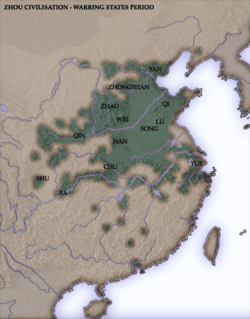Guanzhong
Guanzhong (Kwanchung; simplified Chinese: 关中; traditional Chinese: 關中; pinyin: Guānzhōng; Wade–Giles: Kuan1-chung1; literally: "Inside the Pass"), or Guanzhong Plain, is a historical region of China corresponding to the lower valley of the Wei River. It is called Guanzhong or 'within the passes', as opposed to 'Guandong' or 'east of the pass', i.e., the North China Plain. The North China Plain is bordered on the west by mountains. The Yellow River cuts through the mountains at the Hangu Pass separating Guanzhong from Guandong.
Geography
The passes that enclose Guanzhong are:
- Xiao Pass (萧关/蕭關) to the north,
- Hangu Pass (函谷关/函谷關) to the east (see also Tongguan County),
- Wu Pass (武关/武關) to the south, and
- Dasan Pass (大散关/大散關) to the west
Historically the most important pass was the Hangu Pass along the Yellow River which separates Guanzhong from the North China Plain. Guanzhong includes the central part of Shaanxi and the extreme west of modern Henan.
The average altitude of the Guanzhong Plain is around 500 metres. Xi'an, the capital of Shaanxi, is the largest city in the Guanzhong plain, which also contains the cities of Tongchuan, Baoji, Xianyang and Weinan.
History

Guanzhong was the homebase of Zhou who conquered the Shang dynasty to establish the Zhou dynasty in 1045/46 BC. After the Quanrong nomads overran the Guanzhong region to end the Western Zhou in 771 BC, the Zhou court fled east of the Hangu Pass to Luoyang. The Qin state on the western edge of the Chinese civilization later defeated the nomads and moved its base from Gansu east to Guanzhong. During the Warring States period, Qin became more militaristic and its enemies claimed that it had adopted barbarian customs to help it win battles. It was said that 'Guanzhong produces generals and Guandong produces ministers'. Having fertile soil and good irrigation systems, Qin rose from this region to gain preeminence among the Warring States, and eventually unified China. Since the Western Zhou, the area was the capital region of China for a total of 12 dynasties including the Qin, Western Han, Sui, and Tang. By the Tang dynasty the economic center of China had shifted south to the Yangtze basin and Guanzhong became increasingly dependent on supplies transported via the Grand Canal. After the destruction of Chang'an in the last years of the Tang, Guanzhong became less significant politically as well as economically in later dynasties.[1]
See also
References
- ↑ 冀朝鼎著,朱詩鰲譯《中國歷史上的基本經濟區與水利事業的發展》(北京: 中國社會科學出版社, 1981) pp. 75-76.